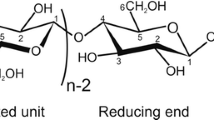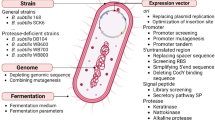Abstract
Enzymes undergo multiple conformational changes in solution, and these dynamics are considered to play a critical role in enzyme activity. Hinge-bending motions, resulting from reciprocal movements of dynamical quasi-rigid bodies, are thought to be related to turnover rate and are affected by the physical properties of the hinge regions. In this study, hinge identification and flexibility modification of the regions by mutagenesis were conducted to explore the relationship between hinge flexibility and catalytic activity. Bacillus circulans xylanase was selected for the identification and mutation of the hinge regions. As a result, turnover rate (V max) was improved approximately twofold in mutants that have more rigid hinge structure, despite the decrease in K m and V max/K m. This result indicates that the rigidly mutated hinge has positive effects on B. circulans xylanase activity.




Similar content being viewed by others
References
Bailey MJ, Biely P, Poutanen K (1992) Interlaboratory testing of methods for assay of xylanase activity. J Biotechnol 23(3):257–270
Bradford MM (1976) A rapid and sensitive method for the quantitation of microgram quantities of protein utilizing the principle of protein dye binding. Anal Biochem 72(1–2):248–254
Fisher CL, Pei GK (1997) Modification of a PCR-based site-directed mutagenesis method. Biotechniques 23(4):570–574
Frey PA (2001) Strong hydrogen bonding in molecules and enzymatic complexes. Magn Reson Chem 39((Spec. Iss.)):S190–S198
Hammes GG (2002) Multiple conformational changes in enzyme catalysis. Biochemistry 41(26):8221–8228
Hayward S (1999) Structural principles governing domain motions in proteins. Proteins Struct Funct Genet 36(4):425–435
Hayward S, Berendsen HJC (1998) Systematic analysis of domain motions in proteins from conformational change: new results on citrate synthase and T4 lysozyme. Proteins Struct Funct Genet 30(2):144–154
Joo JC, Pack SP, Kim YH, Yoo YJ (2011) Thermostabilization of Bacillus circulans xylanase: computational optimization of unstable residues based on thermal fluctuation analysis. J Biotechnol 151(1):56–65
Kim T, Joo JC, Yoo YJ (2012) Hydrophobic interaction network analysis for thermostabilization of a mesophilic xylanase. J Biotechnol 161(1):49–59
Krivov GG, Shapovalov MV, Dunbrack RL Jr (2009) Improved prediction of protein side-chain conformations with SCWRL4. Proteins Struct Funct Bioinform 77(4):778–795
Lineweaver H, Burk D (1934) The determination of enzyme dissociation constants. J Am Chem Soc 56(3):658–666
Ludwiczek ML, Heller M, Kantner T, McIntosh LP (2007) A Secondary xylan-binding site enhances the catalytic activity of a single-domain family 11 glycoside hydrolase. J Mol Biol 373(2):337–354
Ma B, Shatsky M, Wolfson HJ, Nussinov R (2002) Multiple diverse ligands binding at a single protein site: a matter of pre-existing populations. Protein Sci 11(2):184–197
Muilu J, Törrönen A, Peräkylä M, Rouvinen J (1998) Functional conformational changes of endo-1,4-xylanase II from Trichoderma reesei: a molecular dynamics study. Proteins Struct Funct Genet 31(4):434–444
Plesniak LA, Wakarchuk WW, McIntosh LP (1996) Secondary structure and NMR assignments of Bacillus circulans xylanase. Protein Sci 5(6):1118–1135
Pollet A, Vandermarliere E, Lammertyn J, Strelkov SV, Delcour JA, Courtin CM (2009) Crystallographic and activity-based evidence for thumb flexibility and its relevance in glycoside hydrolase family 11 xylanases. Proteins Struct Funct Bioinform 77(2):395–403
Potestio R, Pontiggia F, Micheletti C (2009) Coarse-grained description of protein internal dynamics: an optimal strategy for decomposing proteins in rigid subunits. Biophys J 96(12):4993–5002
Radivojac P, Obradovic Z, Smith DK, Zhu G, Vucetic S, Brown CJ, Lawson JD, Dunker AK (2004) Protein flexibility and intrinsic disorder. Protein Sci 13(1):71–80
Schein CH, Noteborn MHM (1988) Formation of soluble recombinant proteins in Escherichia coli is favored by lower growth temperature. BioTechnology 6(3):291–294
Schramm AM, Mehra-Chaudhary R, Furdui CM, Beamer LJ (2008) Backbone flexibility, conformational change, and catalysis in a phosphohexomutase from Pseudomonas aeruginosa. Biochemistry 47(35):9154–9162
Schulz GE (1991) Domain motions in proteins. Curr Opin Struct Biol 1(6):883–888
Sime JT (1999) Applications of biocatalysis to industrial processes. J Chem Educ 76(12):1658–1661
Subramaniyan S, Prema P (2002) Biotechnology of microbial xylanases: enzymology, molecular biology, and application. Crit Rev Biotechnol 22(1):33–64
Sung WL, Luk CK, Zahab DM, Wakarchuk W (1993) Overexpression of the Bacillus subtilis and circulans xylanases in Escherichia coli. Protein Expr Purif 4(3):200–206
Tina KG, Bhadra R, Srinivasan N (2007) PIC: protein interactions calculator. Nucleic Acids Res 35(Suppl.2):W473–W476
Wells S, Menor S, Hespenheide B, Thorpe MF (2005) Constrained geometric simulation of diffusive motion in proteins. Phys Biol 2(4):S127–S136
Yon JM, Perahia D, Ghélis C (1998) Conformational dynamics and enzyme activity. Biochimie 80(1):33–42
Zheng L, Baumann U, Reymond JL (2004) An efficient one-step site-directed and site-saturation mutagenesis protocol. Nucleic Acids Res 32(14):e115
Author information
Authors and Affiliations
Corresponding author
Rights and permissions
About this article
Cite this article
Kazuyo, F., Hong, S.Y., Yeon, Y.J. et al. Enhancing the activity of Bacillus circulans xylanase by modulating the flexibility of the hinge region. J Ind Microbiol Biotechnol 41, 1181–1190 (2014). https://doi.org/10.1007/s10295-014-1454-z
Received:
Accepted:
Published:
Issue Date:
DOI: https://doi.org/10.1007/s10295-014-1454-z




